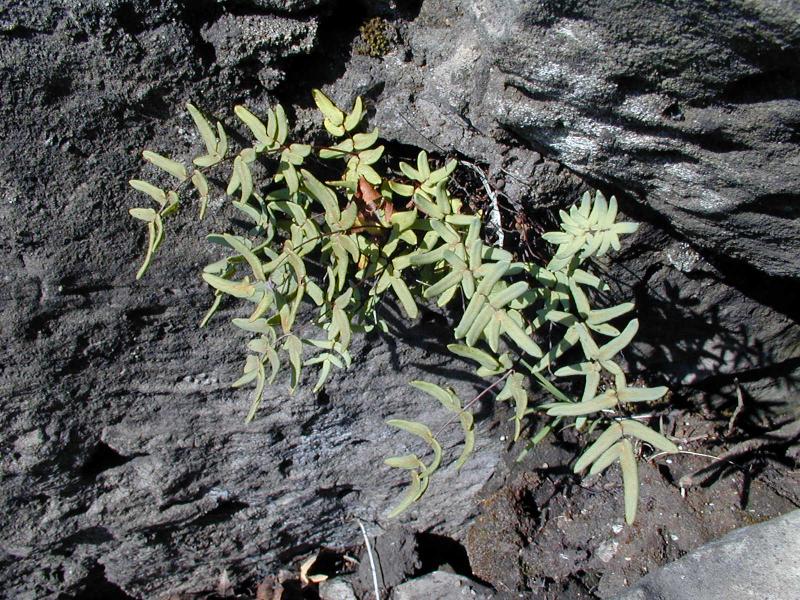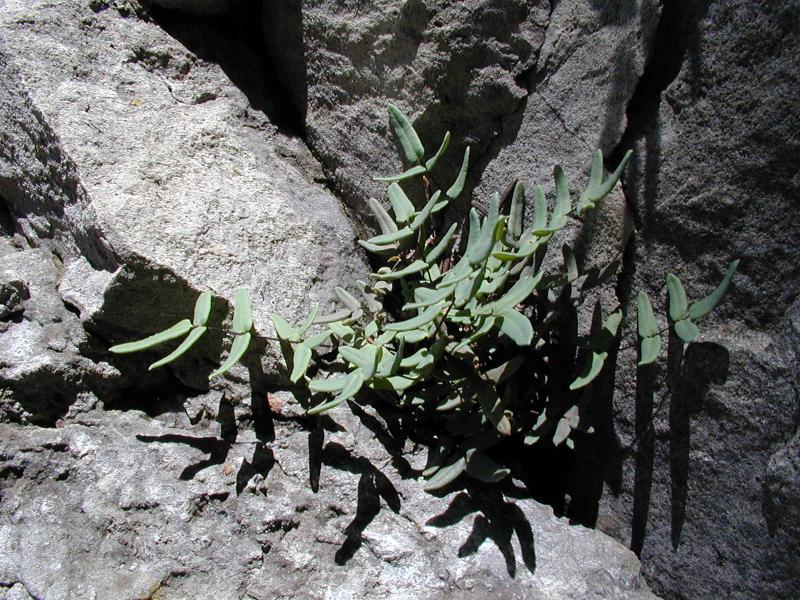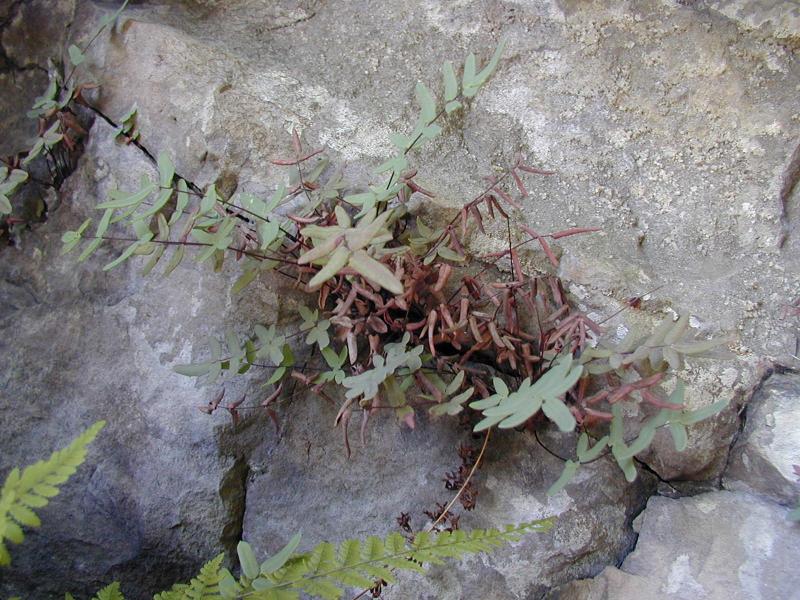Smooth Cliffbrake
Pellaea glabella ssp. glabella None
- Class
- Filicopsida (Ferns)
- Family
- Pteridaceae (Maidenhair-fern Family)
- State Protection
- Threatened
Listed as Threatened by New York State: likely to become Endangered in the foreseeable future. For animals, taking, importation, transportation, or possession is prohibited, except under license or permit. For plants, removal or damage without the consent of the landowner is prohibited.
- Federal Protection
- Not Listed
- State Conservation Status Rank
- S2
Imperiled in New York - Very vulnerable to disappearing from New York due to rarity or other factors; typically 6 to 20 populations or locations in New York, very few individuals, very restricted range, few remaining acres (or miles of stream), and/or steep declines.
- Global Conservation Status Rank
- G5T5
Secure globally - Both the species as a whole and the subspecies/variety are common in the world; widespread and abundant (but may be rare in some parts of its range).
Summary
Did you know?
Scattered throughout upstate New York in fewer than a dozen places, it is a mystery why this fern is so much more rare than it's closely related species Pellaea atropurpurea.
State Ranking Justification
There are 12 known populations and at least four additional historical locations. There are few threats to these populations and a brief trends assessement concluded that this species has been relatively stable in New York for many years. With continued survey work and the discovery of new populations, this plant may one-day move off the active plant list.
Short-term Trends
Populations that have been surveyed more than once are stable.
Long-term Trends
There is no evidence that this plant's distribution or population sizes have changed much. This suggest that the long-term trend is stable.
Conservation and Management
Threats
This fern's habitat is on hard-to-reach cliffs where no immediate threats are known.
Conservation Strategies and Management Practices
There are no management considerations to offer at this time.
Research Needs
Research could be done into why this species is much more rare than the closely related species Pellaea atropurpurea.
Habitat
Habitat
A fern of mainly of calcareous cliffs, often with eroding or crumbly white limestone. These cliffs are often shaded, but not always. They may be associated with river/stream gorges. In a few locations, the cliff faces are composed on sandstone. At one location, this fern is found in the lime mortar of a stone wall (New York Natural Heritage Program 2004). Calcareous cliffs and ledges, usually on limestone substrates (Flora of North America 1993). Calcareous cliffs or bluffs (Gleason and Cronquist 1991). Chiefly on exposed calcareous rocky slopes often damper or more shaded [than typical Pellaea atropurpurea habitat] (Fernald 1970).
Associated Ecological Communities
- Calcareous cliff community
(guide)
A community that occurs on vertical exposures of resistant, calcareous bedrock (such as limestone or dolomite) or consolidated material; these cliffs often include ledges and small areas of talus.
- Cliff community
(guide)
A community that occurs on vertical exposures of resistant, non-calcareous bedrock (such as quartzite, sandstone, or schist) or consolidated material; these cliffs often include ledges and small areas of talus.
Associated Species
- Aquilegia canadensis (wild columbine, red columbine)
- Asplenium rhizophyllum (walking fern)
- Asplenium ruta-muraria (wall-rue)
- Asplenium trichomanes
- Betula alleghaniensis (yellow birch)
- Campanula rotundifolia (hare-bell)
- Centaurea maculosa
- Cryptogramma stelleri (slender cliff-brake, Steller's cliff-brake)
- Cystopteris bulbifera (bulblet fern)
- Cystopteris fragilis (fragile fern)
- Diervilla lonicera (bush-honeysuckle)
- Juniperus virginiana
- Mühlenbergia spp.
- Sambucus canadensis
- Thuja occidentalis (northern white cedar, arbor vitae)
- Tilia americana var. americana (American basswood)
- Toxicodendron radicans
- Tsuga canadensis (eastern hemlock)
- Woodsia ilvensis (rusty woodsia, rusty cliff fern)
Range
New York State Distribution
A fern located on cliffs and rock outcrops, typically restricted to the limestone escarpment that roughly parallel the New York State Thruway from Niagara Falls to Albany and south to the mid-Hudson Valley. Also known the the limestone areas of the St. Lawrence River Valley and scattered alkaline rock outcrops present elsewhere.
Global Distribution
A fern that ranges from Vermont south to Virginia and Tennessee, and west to Minnesota, Kansas, Texas, and the western cordillera.
Identification Comments
General Description
This is a cliff-loving fern with blue-green leaves that stick out at all angles from crevices in the rock. The 10-20 cm long leaf stalks are wiry, shiny, dark purple, and smooth or with only a few hairs. Each leaf has 7-10 pairs of widely-spaced lance-shaped leaflets. The leaflets at the bottom of the leaf stalk are divided into 2-4 additional leaflets but the leaflets become less divided toward the tip of each leaf. The spore packets are arranged along the edge of the leaf and are partially covered by the inrolled edges.
Identifying Characteristics
A fern with monomorphic leaves. The stipe is purple to black. The petiole and rachis is glabrous and lustrous or rarely with remote spreading hairs. The scales at the base of the stipe are lanceolate.
Best Life Stage for Proper Identification
Mature fronds are all that that is needed to identify this plant. If a picture is taken, it should include leaves with close-up of rachis and petiole.
Similar Species
Purple cliff brake (Pellaea atropurpurea) has slightly dimorphic leaves that are stiffly erect, and the petiole and rachis are strongly hairy.
Best Time to See
Mature fronds and sporing fronds may be present July through the first frost. This is also the best period when surveys could be conducted.
- Vegetative
- Fruiting
The time of year you would expect to find Smooth Cliffbrake vegetative and fruiting in New York.
Smooth Cliffbrake Images
Taxonomy
Smooth Cliffbrake
Pellaea glabella ssp. glabella None
- Kingdom Plantae
- Phylum Filicinophyta
- Class Filicopsida
(Ferns)
- Order Filicales
- Family Pteridaceae (Maidenhair-fern Family)
- Order Filicales
- Class Filicopsida
(Ferns)
- Phylum Filicinophyta
Additional Common Names
- Dwarf Cliff Brake
- Smooth Cliff Brake
Synonyms
- Pellaea atropurpurea var. bushii Mackz.
- Pellaea glabella ssp. glabella [Ours are all of this subspecies.]
- Pellaea glabella var. glabella
Additional Resources
Best Identification Reference
Gleason, Henry A. and A. Cronquist. 1991. Manual of Vascular Plants of Northeastern United States and Adjacent Canada. The New York Botanical Garden, Bronx, New York. 910 pp.
Other References
Fernald, M.L. 1950. Gray's manual of botany. 8th edition. D. Van Nostrand, New York. 1632 pp.
Flora of North America Editorial Committee. 1993. Flora of North America, North of Mexico. Volume 2. Pteridophytes and Gymnosperms. Oxford University Press, New York. 475 pp.
Holmgren, Noel. 1998. The Illustrated Companion to Gleason and Cronquist's Manual. Illustrations of the Vascular Plants of Northeastern United States and Adjacent Canada. The New York Botanical Garden, Bronx, New York.
Mitchell, Richard S. and Gordon C. Tucker. 1997. Revised Checklist of New York State Plants. Contributions to a Flora of New York State. Checklist IV. Bulletin No. 490. New York State Museum. Albany, NY. 400 pp.
New York Natural Heritage Program. 2010. Biotics database. New York Natural Heritage Program. New York State Department of Environmental Conservation. Albany, NY.
New York Natural Heritage Program. 2024. New York Natural Heritage Program Databases. Albany, NY.
Reschke, Carol. 1990. Ecological communities of New York State. New York Natural Heritage Program, New York State Department of Environmental Conservation. Latham, NY. 96 pp. plus xi.
Weldy, T. and D. Werier. 2010. New York flora atlas. [S.M. Landry, K.N. Campbell, and L.D. Mabe (original application development), Florida Center for Community Design and Research http://www.fccdr.usf.edu/. University of South Florida http://www.usf.edu/]. New York Flora Association http://newyork.plantatlas.usf.edu/, Albany, New York
Links
About This Guide
Information for this guide was last updated on: February 15, 2005
Please cite this page as:
New York Natural Heritage Program. 2024.
Online Conservation Guide for
Pellaea glabella ssp. glabella.
Available from: https://guides.nynhp.org/smooth-cliff-brake/.
Accessed July 26, 2024.


